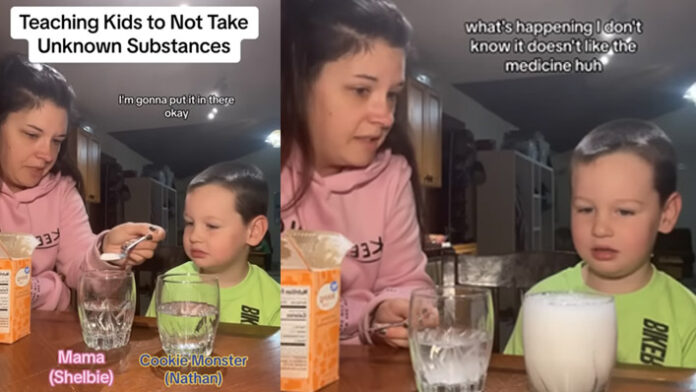Next, she adds baking soda to the second glass, representing Nathan taking someone else’s medicine. This time, the liquid begins to bubble and overflow, capturing her son’s attention. The dramatic reaction visually demonstrates the potential harm of taking unknown substances.
Explaining the Reaction
The mom explains the science behind the experiment: the first glass contains water, while the second contains white vinegar. Baking soda reacts with vinegar to produce carbon dioxide gas, which causes the bubbling and overflow. She uses this reaction to illustrate how taking unknown substances can cause harmful and unpredictable reactions in our bodies.
“Water in one, white vinegar in the other,” she notes in her caption. “They look the same from the outside but baking soda will react very differently in each. This experiment can teach so many things.”
The Lesson: A Lasting Impact
The visual and interactive nature of this experiment leaves a lasting impression on children. By associating the dramatic reaction with the concept of taking unknown substances, children are more likely to remember the lesson and understand the importance of not ingesting anything that doesn’t belong to them.
Why This Method Works
- Engagement: The experiment captures children’s attention, making them more receptive to the lesson.
- Visualization: The visual reaction helps children understand the potential dangers in a concrete way.
- Relatability: Using names and scenarios that children can relate to makes the lesson more personal and impactful.
- Repetition: Repeating the experiment or similar activities can reinforce the lesson over time.
RELATED: Mom’s Reaction to Her Son’s Fit of Rage Can Teach Us All a Lesson in Parenting
Implementing the Experiment at Home
If you want to teach your children about the dangers of unknown substances using this method, here’s how you can set up the experiment at home:
Materials Needed:
- Two clear glasses
- Water
- White vinegar
- Baking soda
- A spoon
Instructions:
- Fill one glass with water and the other with white vinegar. Ensure both liquids are clear and indistinguishable from each other.
- Explain to your child that the glasses represent two people and allow them to choose names for them.
- Add a spoonful of baking soda to the water glass, explaining that this represents taking medicine as prescribed. Observe the lack of reaction.
- Add a spoonful of baking soda to the vinegar glass, explaining that this represents taking someone else’s medicine. Observe the bubbling and overflow.
- Discuss the experiment with your child, explaining why it is important to only take medicines prescribed to them and to never ingest unknown substances.

